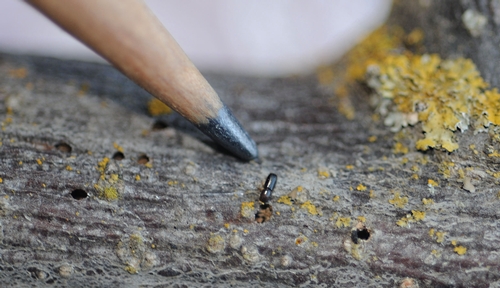Aug 9, 2010
The news is startling, but not totally unexpected.
Thousand cankers disease, which infects and kills black walnut trees, has spread from the western United States to the eastern United States.
Officials announced Aug. 5 that the disease has been detected in Knox County in east Tennessee. This marks the first detection of the disease east of the Mississippi River.
Previously, the disease was known to eight western states: Arizona, California, New Mexico, Colorado, Idaho, Oregon, Utah and Washington.
And now, Tennessee. It's probably in other states across the Great Plains and east of the Mississippi River, as well.
The disease, caused by the walnut twig beetle (Pityophthorus juglandis) in association with a newly described fungus with the proposed name of Geosmithia morbida), occurs only on walnut species. Eastern black walnut is one of the most susceptible species.
By itself, the walnut twig beetle doesn't present a major problem. Together they wreak havoc.
A pest alert, distributed by the U.S. Forest Service and co-authored by Davis-based researcher Steve Seybold, is sounding the alarm
Seybold, research entomologist with the U.S. Forest Service, Pacific Southwest Research Station, Davis, and a faculty affiliate of the UC Davis Department of Entomology, says the disease symptoms to watch for are branch mortality; numerous small cankers on branches and the main stem of the tree; and the entry and exit holes of the tiny bark beetles. (See news article on presence of the disease in Davis.)
In an attempt to stop the spreading of the disease, the Tennessee Department of Agriculture (TDA) plans to quarantine Knox County to prohibit the movement of firewood and black walnut nursery stock and to limit the movement of black walnut timberland.
The TDA's Division of Forestry estimates that the state has 26 million black walnut trees (both on public and private land). They are valued as high as $1.47 billion.
That's "billion" with a "B."
The losses would be more than monetary, though.
We received a telephone call from a Washington state resident today who is worried--and rightfully so--that his two 100-year-old majestic black walnut trees might contract the disease.
And to think that they could be felled by this duo: a fungus hitching a ride on a tiny walnut twig beetle boring into a tree.
It's a beetle that's smaller than a grain of rice.
Thousand cankers disease, which infects and kills black walnut trees, has spread from the western United States to the eastern United States.
Officials announced Aug. 5 that the disease has been detected in Knox County in east Tennessee. This marks the first detection of the disease east of the Mississippi River.
Previously, the disease was known to eight western states: Arizona, California, New Mexico, Colorado, Idaho, Oregon, Utah and Washington.
And now, Tennessee. It's probably in other states across the Great Plains and east of the Mississippi River, as well.
The disease, caused by the walnut twig beetle (Pityophthorus juglandis) in association with a newly described fungus with the proposed name of Geosmithia morbida), occurs only on walnut species. Eastern black walnut is one of the most susceptible species.
By itself, the walnut twig beetle doesn't present a major problem. Together they wreak havoc.
A pest alert, distributed by the U.S. Forest Service and co-authored by Davis-based researcher Steve Seybold, is sounding the alarm
Seybold, research entomologist with the U.S. Forest Service, Pacific Southwest Research Station, Davis, and a faculty affiliate of the UC Davis Department of Entomology, says the disease symptoms to watch for are branch mortality; numerous small cankers on branches and the main stem of the tree; and the entry and exit holes of the tiny bark beetles. (See news article on presence of the disease in Davis.)
In an attempt to stop the spreading of the disease, the Tennessee Department of Agriculture (TDA) plans to quarantine Knox County to prohibit the movement of firewood and black walnut nursery stock and to limit the movement of black walnut timberland.
The TDA's Division of Forestry estimates that the state has 26 million black walnut trees (both on public and private land). They are valued as high as $1.47 billion.
That's "billion" with a "B."
The losses would be more than monetary, though.
We received a telephone call from a Washington state resident today who is worried--and rightfully so--that his two 100-year-old majestic black walnut trees might contract the disease.
And to think that they could be felled by this duo: a fungus hitching a ride on a tiny walnut twig beetle boring into a tree.
It's a beetle that's smaller than a grain of rice.
Attached Images:

Walnut Twig Beetle